- Bioaccumulated limestone from „Pchelari” deposit
- Quartz-feldspar clay sandstone from “Keremidkite plot І” deposit
- White bentonite clays from “Ralitsa” deposit
- Amorphous silicate - acid volcanic tuffisites from “Ovraga” deposit
- Clay marl from “Ralitsa” deposit
- Clay type “Redolit”
- Clay type “Vodentsi"
BIOACCUMULATED LIMESTONE FROM „PCHELARI” DEPOSIT
Bioaccumulated limestone is characterized with high purity and is therefore appropriate raw material as additives in fodder industry, ceramic bodies and glazes.
Location: “Pchelari” deposit comprises an area of 174 decare and is located in Stambolovo municipality, Haskovo district 24 km to the east of town of Kardzhali and 33 km southeast from the town of Haskovo.
Geological characteristics: “Pchelari” deposit is located within the Eastern Rhodopean Paleogene depression. It is set up of Oligocene sedimentary materials belonging to the unit of massive reef limestones. Within the deposit the unit is represented by massive colonial-detrital limestone with micro to cryptocristal carbonate cement. As a whole limestones are white to grey-white.
The whole limestone complex in the deposit has maximal thickness of 45 m and falls in a thrust tectonic zone.
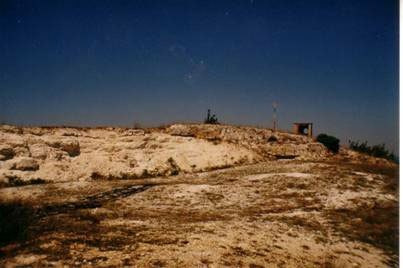
Quarry in the outcrop of bioaccumulated limestone in “Pchelari” deposit
The limestones are overlain by a thin layer of deluvial deposits which facilitates the extractions of the resource. The quantity of proved reserves estimated as a result of exploration activities in the deposit is 6,58 million tons.
Technological characteristics:
Chemical composition, %:
Bioaccumulated limestones are characterized by constant chemical composition.
Average chemical composition, %:
CaO |
MgO |
MnO |
Fe2O3 |
Al2O3 |
SiO2 |
TiO2 |
K2O |
Na2O |
P2O5 |
SO3- |
IL |
54,26 |
0,25 |
0,04 |
0,17 |
0,47 |
1,75 |
0,03 |
< 0,05 |
0,06 |
< 0,03 |
< 0,03 |
42,56 |
The average content of calcium carbonate is 97,13% with average density 2,46 g/cm3. Its microcomponent composition for heavy and other hazardous elements lies below the registration limit of the corresponding analytical methods. „Gravelita” Ltd. has a Certificate issued by “Eurotest-control” Sofia for “first quality” product which is appropriate as a mineral supplement to poultry fodder.
The high calcium content combined with low quantity of coloring oxides (Fe2O3 – to 0,23%, MnO – to 0,05% and TiO2 – to 0,05%) permits its use in the ceramic industry for tiles. Due to their high purity limestones could find application in many other industrial branches (Flue Gas Desulpherization Systems, etc ).
Mineral composition:The rocks are monomineral, containing calcite > 98%.
QUARTZ-FELDSPAR CLAY SANDSTONE FROM THE ”KEREMIDKITE – PLOT I” DEPOSIT
The quartz-feldspar clay sandstone is a natural, universal raw material representing a natural ceramic tile, by which pegmatite (feldspar), clay and quartz components are successfully substituted.
The clay sandstone is a new, non-traditional raw material discovered, patented, and introduced by Gravelita Ltd.
Location: The deposit of “Keremidkite – plot I” occupies an area of 70 decares. It is located about 20 km south of the town of Haskovo, within the borders of Stambolovo,about 900 m southeast of Dolno Botevo.
Geological characteristics: The composition of the “Keremidkite – plot I” deposit, ranges from reddish-violet quartz-feldspar clay sandstones to conglomerates from the Priabone age. The stratigraphical position of the Priabone terrigenous sediments is determined by materials ranging from gray sandstones to fine-clastic conglomerates, from the Leshnikovo Formation found beneath them. Only quaternary alluvial and proluvial sediments are found above the red-violet terrigenous sediments in the area.
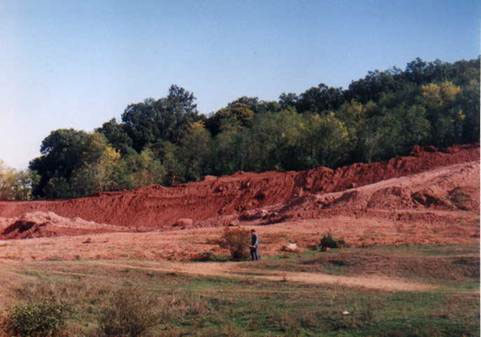
Experimental quarry in the “Keremidkite” deposit
There are 1,44 million tons of proven reserves and 0,82 million tons of proven resources in the deposit of “Keremidkite – plot I” as a result of exploration works. The estimated reserves within the whole deposit exceed 50 million tons, taking into account the data for lateral and vertical distribution of the quartz-feldspar clay sandstones.
Technological characteristics:
The technological investigations of quartz-feldspar clay sandstone indicated the raw material as ranging from poly-mineral, middle-plastic and low-sensitive to drying clay, coarsely-dispersed, with middle content of coloring oxides as Fe2O3 и TiO2.
Chemical composition, %::
The mineralization has a simple composition varying within limited ranges.
Average chemical composition, %:
Al2O3 |
Fe2O3 |
MgO |
CaO |
TiO2 |
Na2O |
K2O |
IL |
12,13 |
2,54 |
0,74 |
0,85 |
0,32 |
2,57 |
2,99 |
2,68 |
Physical-mechanical properties:
Molding moisture – 21 - 22 % |
Plasticity by Pfeferkorn – 23 - 24 % |
Air shrinkage – 4 - 5 % |
Firing shrinkage at 1170-1190 оС – 6,5 - 7,5 % |
Mechanical bending strength ongreen – 1,7-1,8 МРа |
Меchanical bending strength after firing at 1100 оС – 18 - 20 МРа |
Mechanical bending strength after firing at 1170 оС – 26 - 36 МРа |
Water absorption at 1170 оС – 3 - 5 % |
WHITE BENTONITE CLAYS FROM THE “RALITSA” DEPOSIT
Gravelita Ltd. offers white bentonite clays from the „Ralitsa” deposit, finding applications in the electro-porcelain and faience-ceramics industry.
Location: The deposit of “Ralitsa” is situated 22 km southeast from the town of Haskovo and covers an area of 127 decares. It is located in the place named “Tokmakliyski bair”, being 3.7 km southeast of Stambolovo and 3 km northwest of Dolno Botevo.
Geological characteristics: The deposit of “Ralitsa” is located within the Eastern Rhodopean Paleogene depression. It consists of Oligocene volcanic-sedimentary tuffs, alternating from thin to medium layered marls, tuffaceous marls, psamitic medium-grained tuffaceous sandstones, white fine-grained (soap-like) and grey-white bentonite clays.
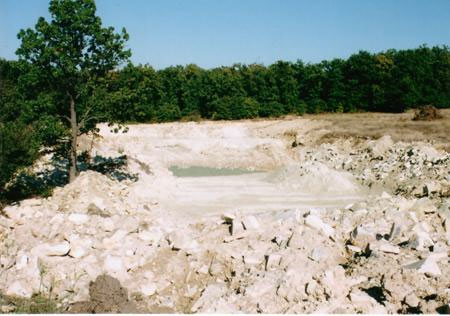
Exploitation quarry in “Ralitsa” deposit
Bentonite clays form strata range from several centimeters to 1.55 m in thickness. White bentonites form the productive level, including four layers with average thickness of 0.76 to 1.16 m. The amount of proven reserves in “Ralitsa” is 541 345 t.
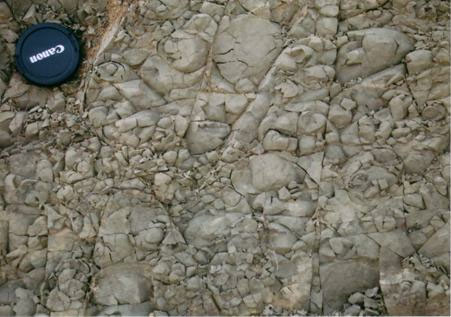
A general view of bentonite raw material in the exploitation quarry
Technological characteristics:
Chemical composition and physical-mechanical properties of the bentonite clay from the “Ralitsa” deposit correspond to the manufacturers’ requirements regarding the production of electro-porcelain, faience and ceramic tiles.
Chemical composition, %:
Average chemical composition, %:
SiO2 |
Al2O3 |
TiO2 |
Fe2O3 |
CaO |
MgO |
Na2O |
K2O |
IL |
57,80 |
13,83 |
0,18 |
1,78 |
7,27 |
2,62 |
0,42 |
1,05 |
14,58 |
The mix of heavy metals (Pb, Zn, Cd, As) in the composition, does not exceed 0,015%.
Mineral composition: The mineral composition of white bentonite clays “Ralitsa” mostly includes montmorillonite (~ 90%) and calcite aggregates. Single fine quartz pieces of around 0,1 mm in size are observed, together with feldspar and mica. X-ray diffraction analysis confirms the presence of montmorillonite, clinoptilolite, quartz, crystobalite, calcite and feldspars (mainly plagioclase and a minor amount of feldspar).
Physical-mechanical properties:
Properties |
Bentonite clay type “Ralitsa” |
Аbsolute moisture, % |
50,0 |
Relative moisture, % |
34,2 |
Plasticity by Pfeferkorn, % |
34,5 |
Air shrinkage, % |
9,6 |
Air shrinkage at 1100° С, % |
13,0 |
Меchanical bending strength at raw state, МРа |
2,0 |
Water absorption at 1100° С, % |
30,0 |
Меchanical bending strength at 1100° С, МРа |
6,5 |
Color after firing |
white |
AMORPHOUS SILICATE - ACID VOLCANIC TUFFISITES FROM THE “OVRAGA” DEPOSIT
Amorphous silicate – acid volcanic tuffisites with high content of alkaline – is a unique mineral which successfully substitutes feldspar in ceramic tiles compositions for production of floor and wall tiles. This has two main advantages: 1. the raw material is micronized so that the time of wet grinding can be reduced to 2-3 hours; 2. the presence of volcanic glass lowers the firing temperature by 20-30°C. The raw material is used as an addition in the cement industry. It is common around the exploration area of “Stambolovo”, and its thin overburden facilitates the open pit exploitation.
Location: “Ovraga” deposit consists of two sectors with a total area of 66 decare (35 da – sector „North” and 31 da – sector “South”). It is situated in Stambolovo, Haskovo district, 4 km southeast of Stambolovo.
Geological characteristics: the deposit is situated in the East Rhodopian Paleogene depression. The geological structure in the area of the deposit was formed as a result of the Oligocene polychronic high-explosive acid to moderately acid volcanism (throat facies), within a thick volcanic-tectonic zone with southeast-northwest trending. Because of post-volcanic low-temperature hydrothermal metasomatic processes, tuffisitic materials have undergone partial or complete modification (east part – clinoptilolitic type mineralization, north part - montmorillonitic type mineralization).
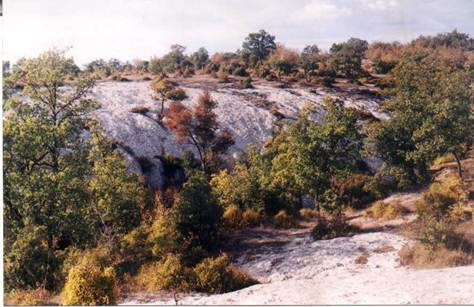
Landscapeviewofacid volcanic tuffisitesin “Ovraga”deposit
Technological characteristics:
Chemical composition, %:
“Ovraga”deposit |
SiO2 |
Al2O3 |
TiO2 |
Fe2O3 |
CaO |
MgO |
Na2O |
K2O |
IL |
Sector “North” |
69,58 |
16,02 |
0,16 |
0,85 |
1,24 |
0,41 |
1,74 |
4,58 |
6,79 |
Sector “South” |
72,74 |
11,49 |
0,18 |
0,74 |
2,09 |
0,34 |
1,07 |
4,27 |
6,93 |
Mineral composition: Acid tuffisites consist of psamitic to psephitic pumice aggregations with vitroclastic cement. Their mineral composition is represented by amorphous volcanic glass with inserts of crystaloclasts of plagioclase, feldspar, biotite and lithoclasts of altered marls, andesites and metamorphic rocks.
As secondary mineralizations, clinoptilolit, montmorillonit and crystobalit were established.
As a result of exploration activities in the „Ovraga” deposit, 1,98 million tons reserves and 0,51 million tons resources of amorphous silicate are estimated and proven. The amount of estimated prognosis reserves of amorphous silicate includes 0,42 million tons clinoptilolite zeolitites with 64% average content of clinoptilolit.
CLAY MARL FROM “RALITSA” DEPOSIT
Location: The deposit of “Ralitsa” is situated 22 km southeast from the town of Haskovo and takes an area of 127 decares. It is located in the place named “Tokmakliyski bair”, 3.7 km southeast from Stambolovo and 3 km northwest from Dolno Botevo.
Geological characteristics: The deposit of “Ralitsa” is located within the Eastern Rhodopean Paleogene depression. It consists of Oligocene volcanic-sedimentary tuffs, with alternations of thin to medium layered marls, tuffaceous marls, psamitic medium-grained tuffaceous sandstones, white fine-grained (soap-like) and grey-white bentonite clays.
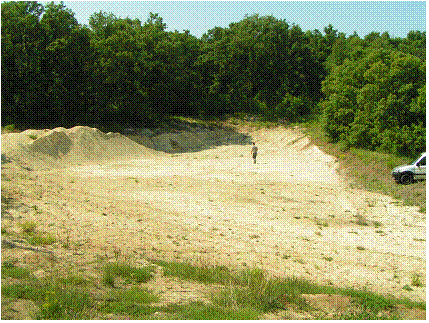
Experimental quarry of clay marl type “Ralitsa”
The clay marls cover a part of the bentonite-bearing productive horizon and actually represent its external layer. In the borders of the bentonitic deposit the marl row material occupies an area of 45 decare. Taking into account that the average thickness is 4,5 m, the prognostic resources amount to 405 000 t.
Technological characteristics:
Mineral composition: The rock is set up by equal parts (1:1) of micro-flaked clay minerals and micro-grained calcite, and this ratio changes in most argillized or carboniferous sectors for the account of one or the other component. 5 – 10% shells from plankton foraminifers formed by micro-grained calcite and filled up with coarse clear calcite are observed. Single fragments from thick-shell bivalves and ostracodes are rarely found, and their inner parts are filled up with micro-grained calcite. Terrigenous clastic impurity is in indistinct quantity, close or less than the biogenic one. It is represented by fine-psamitic and the most often aleurolitic sized grains of quartz, feldspar and mica flakes.
Chemical composition, %:
CaO |
MgO |
Al2O3 |
SiO2 |
Fe2O3 |
TiO2 |
Na2O |
K2O |
IL |
25,1 |
1,5 |
9,0 |
36,0 |
2,6 |
0,3 |
0,5 |
1,7 |
22,4 |
Granulometric composition:
Size of fractions (mm) |
Quantity (%) |
above 60 |
9.90 |
10 - 60 |
44.72 |
5 - 10 |
14.07 |
1 - 5 |
24.43 |
below 1 |
6.88 |
Physical-mechanical properties of semi-dry molded samples from clay marl:
Firing |
Меchanical |
Water |
Apparent |
Apparent |
Full |
°С |
МРа |
% |
kg/m3 |
% |
% |
950 |
4,67 |
35,60 |
1313,81 |
46,78 |
-0,33 |
1000 |
7,01 |
34,65 |
1291,91 |
44,75 |
-1,30 |
1050 |
5,69 |
35,00 |
1268,39 |
44,38 |
-1,93 |
1100 |
6,09 |
37,07 |
1260,47 |
46,68 |
-2,35 |
1150 |
7,38 |
36,99 |
1281,26 |
47,38 |
-1,53 |
Physical-mechanical properties of plastic molded samples from clay marl:
Firing |
Water |
Apparent |
Apparent |
Firing |
Full |
°С |
% |
kg/m3 |
% |
% |
% |
950 |
34.88 |
1394.03 |
48.62 |
0.58 |
6.20 |
1000 |
35.68 |
1342.74 |
47.91 |
-0.70 |
4.92 |
1050 |
36.70 |
1322.73 |
48.54 |
-1.17 |
4.45 |
1100 |
37.81 |
1312.28 |
49.61 |
-0.72 |
4.90 |
1150 |
34 |
1429.25 |
48.91 |
0.30 |
5.92 |
The data of analyses determine the clay marl “Ralitsa” as middle-plastic, low sensitive to drying, dispersed and acid clay, low melted, with low content of coloring oxides as Fe2O3 and TiO2.
By X-ray diffraction of semidry molded samples is established, that the base crystal phases are quartz, аnorthite, wollastonite and gehlenite.
The processes of phase formation lead to complete assimilation of coloring oxides Fe2O3 and TiO2, leading to higher whiteness of ceramic samples, possessing maximum value (62,8%) at temperaures 1100 °С and 1150 °С.
Phase semi-quantitative composition of thermal treated samples:

CLAY TYPE “REDOLIT”
The clay is high-temperature-melted with red color after firing and it is appropriated for red ceramic bodies for production of bricks, clinker and ceramic tiles.
Location: the deposit of clay type “Redolit” is located 1 km west of Madzhari village, Stambolovo municipality, Haskovo district.
Geological characteristics: in geological aspect the deposit is situated in the East Rhodopian Paleogene depression, among the volcanogenic-sedimentary rocks of Perpereshki rhyolitic complex of the Late Oligocene. The rock composition here is represented by stratous ash to psamitic tuffs, igneous breccia, clays and tuffaceous sandstones to conglomerates. In the area of intersection of stratofabric thrust with crossing fault formations the low-temperature hydrothermal solutions have argillized twice the rock composition. Primary the rocks are argillized into kaolinite – montmorillonite facies and they have distinct grey-white color. The secondary argillization of kaolinitic type accompanied by abundant hematitic impregnation and distinct red color is named Redolit clay.
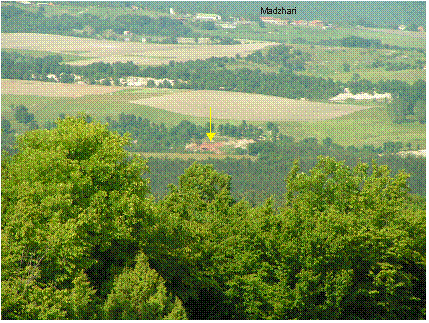
Outcrop of clay type “Redolit”
Technological characteristics:
Mineral composition: Clay type "Redolit" is polymineral – kaolinite type, with high content of coloring oxides. It contains only kaolinite and mica traces as plastic components. The non-plastic components in the raw materials are quartz, plagioclase and orthoclase. The material is middle-fictile and middle-sensitive to drying and has low air shrinkage.
Chemical composition, %:
Al2O3 |
CaO |
Fe2O3 |
K2O |
MgO |
Na2O |
SiO2 |
TiO2 |
IL |
Moisture |
29,49 |
0,41 |
4,14 |
0,55 |
0,19 |
0,11 |
50,67 |
0,82 |
13,01 |
2,63 |
Dispersity: - The dispersity of the clay is determined by sieving and sedimentation analysis according to Robinson-Glushkovski method.
Granulometric composition of clay type “Redolit”:
Fractions, mm |
Content, % |
above 5 |
1,50 |
2,0 – 5 |
6,50 |
0,5 – 2,0 |
5,10 |
0,1 – 0,5 |
8,50 |
0,1 – 0,063 |
15,30 |
above 0,063 |
58,34 |
under sieve 0,063 |
41,66 |
Sedimentation analysis of clay type “Redolit”:
Fractions, mm |
Content,% |
above 0,063 |
58,34 |
0,06 – 0,01 |
13,41 |
0,01 – 0,005 |
3,0 |
0,005 – 0,001 |
18,4 |
below 0,001 |
16,85 |
Physical-mechanical properties of clay “Redolit”:
Properties |
Clay type “Redolit” |
Relative moisture, % |
21,70 |
Absolute moisture, % |
27,70 |
Plasticity by Pfeferkorn, % |
24,50 |
Air shrinkage, % |
4,40 |
Drying sensitive coefficient |
1,20 |
Mechanical bending strength at a raw state, МРа |
1,50 |
Mechanical bending strength at firing, МРа |
|
900оС |
2,76 |
1000 оС |
4,22 |
1100 оС |
5,92 |
Full shrinkage, % |
|
900 оС |
5,20 |
1000 оС |
9,00 |
1100 оС |
14,00 |
Water absorption , % |
|
900 оС |
22,50 |
1000 оС |
18,10 |
1100 оС |
13,50 |
CLAY TYPE “VODENTSI”
Clay “Vodentsi” is kaolinite–montmorillonitic type clay (natural ceramic body), appropriate raw material for producing of cover ceramic tiles.
Location:the deposit of “Vodentsi” clay is situated close to the west-south part of the Vodentsi village, Stambolovo municipality, Haskovo district.
Geological characteristic: in geological aspect it is situated in the East Rhodopian Paleogene depression and belongs to the terrigenous-volcanogenic rocks of Valche pole molasse aged Late Oligocene – Early Miocene. It is represented by irregular alternation of tuffaceous aleurolites, pelite-aleurolites and pelites where the volcanogenic and terrigenic components are in approximately equal quantities. The productive level of the deposit is almost sub-horizontal. Its effective thickness exceeds 30 m. The main color of the rocks is grey-white in dry state. As a result of autogenic and sequential processes the rocks from the productive level are affected of kaolinite-montmorillonitic type argillization.

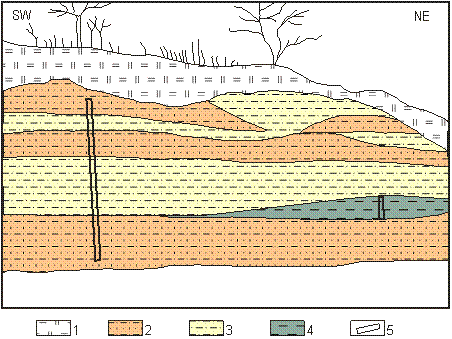
Experimental quarry in “Vodentsi” deposit
1. Soil layer; 2. tuffaceous aleurolite; 3. Tuffaceous pelite-aleurite; 4. Pelite;
5. Sample location
Technological characteristics:Clay type “Vodentsi” is poly-mineral – with clay components of kaolinite and montmorillonite including quartz, plagioclase and mica traces. It is semi-acid, fine-dispersed, middle-fictile and middle-sensitive to drying, with low air shrinkage and good mechanical bending strength at raw state as well as firing state. The material has low firing temperature and specific uniformly red-colored ceramic body after firing.The estimated prognosis resources in the deposit exceed 2 million tons.
Chemical composition, %:
Al2O3 |
CaO |
Fe2O3 |
K2O |
MgO |
Na2O |
SiO2 |
TiO2 |
IL |
Moisture |
17,87 |
1,39 |
2,96 |
3,65 |
0,78 |
1,24 |
60,33 |
0,46 |
11,03 |
6,33 |
Dispersity:
Granulometric composition:
Fractions, mm |
Content, % |
above 5 |
0,1 |
2,0 – 5 |
0,5 |
0,5 – 2,0 |
1,2 |
0,1 – 0,5 |
17,7 |
0,1 – 0,063 |
7,75 |
above 0,063 |
27,25 |
under sieving 0,063 |
72,75 |
Sedimentation analysis:
Fractions, mm |
Content, % |
above sieve 0,063 |
27,25 |
0,06-0,01 |
16,30 |
0,01-0,005 |
5,35 |
0,005-0.001 |
10,50 |
below 0,001 |
40,60 |
Physical-mechanical properties:
Properties |
Clay type “Vodentsi” |
Relative moisture, % |
23,85 |
Absolute moisture, % |
31,40 |
Plasticity by Pfeferkorn,% |
25,00 |
Air shrinkage, % |
4,50 |
Drying sensitive coefficient |
1,30 |
Mechanical bending strength at raw state, МРа |
2,60 |
Mechanical bending strength after firing at, МРа |
|
900оС |
7,25 |
1000 оС |
13,90 |
1100 оС |
14,70 |
Full shrinkage , % |
|
900 оС |
8,00 |
1000 оС |
10,00 |
1100 оС |
15,00 |
Water absorption, % |
|
900 оС |
17,90 |
1000 оС |
6,00 |
1100 оС |
2,70 |
Copyright © 2016 - Gravelita Ltd. - All rights reserved.
Questions or problems regarding this page? Please contact the Webmaster.